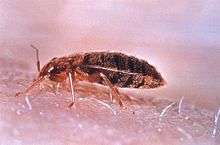Hematophagy


Hematophagy (sometimes spelled haematophagy or hematophagia) is the practice by certain animals of feeding on blood (from the Greek words αἷμα haima "blood" and φάγειν phagein "to eat"). Since blood is a fluid tissue rich in nutritious proteins and lipids that can be taken without great effort, hematophagy has evolved as a preferred form of feeding for many small animals, such as worms and arthropods. Some intestinal nematodes, such as Ancylostomids, feed on blood extracted from the capillaries of the gut, and about 75 percent of all species of leeches (e.g., Hirudo medicinalis), a free-living worm, are hematophagous. Some fish, such as lampreys and candirus, and mammals, especially the vampire bats, and birds, such as the vampire finches, hood mockingbirds, the Tristan thrush, and oxpeckers also practise hematophagy.
Mechanism and evolution
These hematophagous animals have mouth parts and chemical agents for penetrating vascular structures in the skin of hosts, mostly of mammals, birds, and fish. This type of feeding is known as phlebotomy (from the Greek words, phleps "vein" and tomos "cutting").
Once phlebotomy is performed (in most insects by a specialized fine hollow "needle," the proboscis, which perforates skin and capillaries; in bats by sharp incisor teeth that act as a razor to cut the skin), blood is acquired either by sucking action directly from the veins or capillaries, from a pool of escaped blood, or by lapping (again, in bats). To overcome natural hemostasis (blood coagulation), vasoconstriction, inflammation, and pain sensation in the host, hematophagous animals have evolved hembiochemical solutions, in their saliva for instance, that they pre-inject—and anesthesia and capillary dilation have evolved in some hematophagous species. Scientists have developed anticoagulant medicines from studying substances in the saliva of several hematophagous species, such as leeches (hirudin).
Hematophagy is classified as either obligatory or facultative. Obligatory hematophagous animals can't survive on any other food. Examples include Rhodnius prolixus, a South American assassin bug, and Cimex lectularius, the human bed bug. Facultative hematophages, meanwhile, acquire at least some portion of their nutrition from non-blood sources in at least one of the sexually mature forms. Examples of this include many mosquito species, such as Aedes aegypti, whose males feed on pollen and fruit juice (only) while the females survive strictly by feeding on mammalian blood. In anautogenous species, the female must consume blood in order to produce eggs (obligatory hematophages are by definition also anautogenous).
As a feeding practice, hematophagy has evolved independently in a number of arthropod, annelid, nematode and mammalian taxa. For example, Diptera (insects with two wings, such as flies) have eleven families with hematophagous habits (more than half of the 19 hematophagous arthropod taxa). About 14,000 species of arthropods are hematophagous, even including some genera that were not previously thought to be, such as moths of the genus Calyptra. Several complementary biological adaptations for locating the hosts (usually in the dark, as most hematophagous species are nocturnal and silent to avoid detection) have also evolved, such as special physical or chemical detectors for sweat components, CO2, heat, light, movement, etc.
Medical importance
The phlebotomic action opens a channel for contamination of the host species with bacteria, viruses and blood-borne parasites contained in the hematophagous organism. Thus, many animal and human infectious diseases are transmitted by hematophagous species, such as the bubonic plague, Chagas disease, dengue fever, eastern equine encephalitis, filariasis, leishmaniasis, Lyme disease, malaria, rabies, sleeping sickness, St. Louis encephalitis, tularemia, typhus, Rocky Mountain spotted fever, West Nile fever, Zika fever, and many others.
Insects and arachnids of medical importance for being hematophagous, at least in some species, include the sandfly, blackfly, tsetse fly, bedbug, assassin bug, mosquito, tick, louse, mite, midge, and flea.
Hematophagous organisms have been used by physicians for beneficial purposes (hirudotherapy). Some doctors now use leeches to prevent the clotting of blood on some wounds following surgery or trauma. The anticoagulants in the laboratory-raised leeches' saliva keeps fresh blood flowing to the site of an injury, actually preventing infection and increasing chances of full recovery. In a recent study a genetically engineered drug called desmoteplase based on the saliva of Desmodus rotundus (the vampire bat) was shown to improve recovery in stroke patients.
Human hematophagy
Many human societies also drink blood or use it to manufacture foodstuffs and delicacies. Cow blood mixed with milk, for example, is a mainstay food of the African Maasai. Marco Polo reported that Mongols drank blood from their horses if necessary. Many places around the world eat Black pudding. Some societies, such as the Moche, had ritual hematophagy, as well as the Scythians, a nomadic people of Russia, who drank the blood of the first enemy they killed in battle. Some religious rituals and symbols seemingly mirror hematophagy, such as in the transubstantiation of wine as the blood of Jesus Christ during Christian eucharist. Psychiatric cases of patients performing hematophagy also exist. Sucking or licking one's own blood from a wound is also a common human behavior, and in small enough quantities is not considered taboo. Finally, human vampirism has been a persistent object of literary and cultural attention.
See also
- Chupacabra
- Consumer-resource systems
- Natural reservoir
- Tick-borne disease
- Transmission (medicine)
- Zoonosis
References
- Scharfetter C, Hagenbuchner K (1967). "Blutdurst als Symptom. Ein seltsamer Fall von Bluttrinken". Psychiatr Neurol. Basel. 154 (5): 288–310.
- Ciprandi A, Horn F, Termignoni C (2003). "Saliva of hematophagous animals: source of new anticoagulants" (PDF). Rev. Bras. Hematol. Hemoter. 25 (4): 250–262.
- Markwardt F (October 2002). "Hirudin as alternative anticoagulant--a historical review". Semin. Thromb. Hemost. 28 (5): 405–14. doi:10.1055/s-2002-35292. PMID 12420235.
- Ribeiro JM (September 1995). "Blood-feeding arthropods: live syringes or invertebrate pharmacologists?". Infect Agents Dis. 4 (3): 143–52. PMID 8548192.
External links
| Look up bloodsucker in Wiktionary, the free dictionary. |
- Schutt, W. A website dedicated to the study of blood feeding creatures
- Galun, R. Evolution of Hematophagy
- Beaty, LC. Host-Seeking Behavior in Hematophagous Mosquitoes
